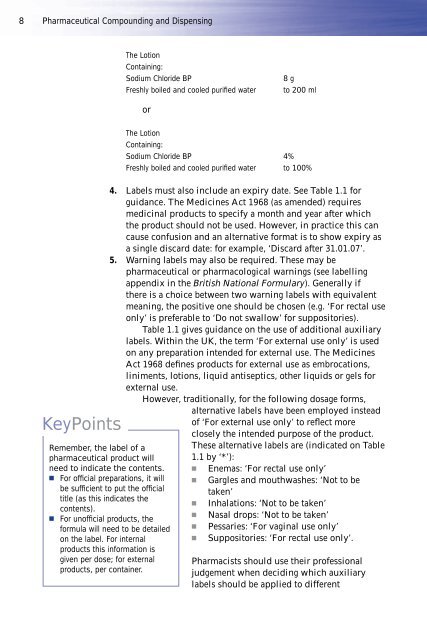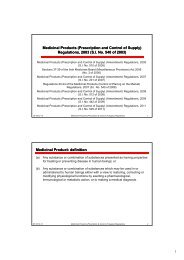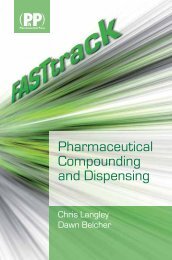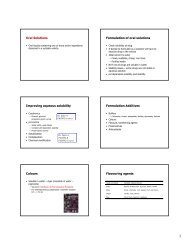Pharmaceutical Compounding and Dispensing - Pharmaceutics
Pharmaceutical Compounding and Dispensing - Pharmaceutics
Pharmaceutical Compounding and Dispensing - Pharmaceutics
You also want an ePaper? Increase the reach of your titles
YUMPU automatically turns print PDFs into web optimized ePapers that Google loves.
8<br />
<strong>Pharmaceutical</strong> <strong>Compounding</strong> <strong>and</strong> <strong>Dispensing</strong><br />
KeyPoints<br />
The Lotion<br />
Containing:<br />
Sodium Chloride BP 8 g<br />
Freshly boiled <strong>and</strong> cooled purifi ed water to 200 ml<br />
or<br />
The Lotion<br />
Containing:<br />
Sodium Chloride BP 4%<br />
Freshly boiled <strong>and</strong> cooled purifi ed water to 100%<br />
4. Labels must also include an expiry date. See Table 1.1 for<br />
guidance. The Medicines Act 1968 (as amended) requires<br />
medicinal products to specify a month <strong>and</strong> year after which<br />
the product should not be used. However, in practice this can<br />
cause confusion <strong>and</strong> an alternative format is to show expiry as<br />
a single discard date: for example, ‘Discard after 31.01.07’.<br />
5. Warning labels may also be required. These may be<br />
pharmaceutical or pharmacological warnings (see labelling<br />
appendix in the British National Formulary). Generally if<br />
there is a choice between two warning labels with equivalent<br />
meaning, the positive one should be chosen (e.g. ‘For rectal use<br />
only’ is preferable to ‘Do not swallow’ for suppositories).<br />
Table 1.1 gives guidance on the use of additional auxiliary<br />
labels. Within the UK, the term ‘For external use only’ is used<br />
on any preparation intended for external use. The Medicines<br />
Act 1968 defi nes products for external use as embrocations,<br />
liniments, lotions, liquid antiseptics, other liquids or gels for<br />
external use.<br />
However, traditionally, for the following dosage forms,<br />
Remember, the label of a<br />
pharmaceutical product will<br />
need to indicate the contents.<br />
For offi cial preparations, it will<br />
be suffi cient to put the offi cial<br />
title (as this indicates the<br />
contents).<br />
For unoffi cial products, the<br />
formula will need to be detailed<br />
on the label. For internal<br />
products this information is<br />
given per dose; for external<br />
products, per container.<br />
alternative labels have been employed instead<br />
of ‘For external use only’ to refl ect more<br />
closely the intended purpose of the product.<br />
These alternative labels are (indicated on Table<br />
1.1 by ‘*’):<br />
Enemas: ‘For rectal use only’<br />
Gargles <strong>and</strong> mouthwashes: ‘Not to be<br />
taken’<br />
Inhalations: ‘Not to be taken’<br />
Nasal drops: ‘Not to be taken’<br />
Pessaries: ‘For vaginal use only’<br />
Suppositories: ‘For rectal use only’.<br />
Pharmacists should use their professional<br />
judgement when deciding which auxiliary<br />
labels should be applied to different





